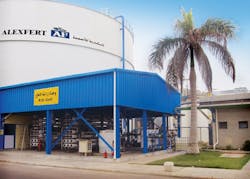AlexFert, a large fertilizer company located in Alexandria, Egypt, was interested in reducing the cost of its high purity water treatment operations by using a reverse osmosis (RO) membrane for a desalination process to reduce the ionic burden on its ion exchange system. Lanxess and its engineering partner, AL-Emain Engineering Co. in Mansoura, Egypt, designed and provided a system to meet the clients’ objectives.
Conceptual Design
Lanxess offers RO and ion exchange system design software called LewaPlus. The use of design software offers a way to project the performance of Lewabrane RO membranes under the expected conditions of service. With only a few inputs (permeate quantity, source and feedwater, temperature and pretreatment steps), LewaPlus will automatically create a default RO system design (see Figure 1) that meets the customers’ stated targets. The software calculates a system array, feed pressures for pump sizing, and permeate quality, as well. The projected permeate quality can be used to assess the reduction in ionic burden on a downstream ion exchange system. The software also provides warnings if design guidelines for critical system parameters are not within limits.
Another aspect of the LewaPlus design software was important in this project. A client often needs to know how the performance of the RO plant will change over time. It is quite common for the equipment supplier to project the performance (feed pressures and permeate quality) on a three-year basis. And this often serves as the basis for guarantees in capital projects. The design software allows the user to enter unique or default values for flux decline ratios (water permeability of the membrane) and salt passage increases over a period of up to seven years. In this project, the user was supplied performance projections of less than one-year, one-year, three-year and five-year performance.
Choosing the Best RO Membrane
RO membrane element selection is usually a function of water source and pretreatment steps. The AlexFert water treatment plant uses canal water as a source (Nile River as origin) with a seasonally variable TDS between 300 and 550 mg/L. The water composition used for the design basis was measured to contain 3 ppm TOC, 0.3 NTU units, SDI of 4, and a total iron content of 0.2 ppm. These levels are generally attributed to waters often prone to organic fouling.
The feed water to the RO is pre-treated by coagulation, cold lime softening and cartridge filtration. Lanxess recommended that the RO system be based on Lewabrane B400 FR membrane element. This RO element is a work horse element for industrial applications. It is a standard pressure element that is characterized by high-flow productivity and salt rejection. Of special importance, the element offers a 0.86-mm feed spacer, which is recommended for potentially fouling waters, such as slow moving canal water. Feed spacers of that height are considered to be the industry standard feed spacer height for situations prone to membrane fouling.
Another important reason for the recommendation for the element relates to silica rejection. The polyamide layer is prepared with a higher level of cross linkage in the barrier layer. In this way, the separation mechanism is more dominated by solution diffusion effects than by anionic repulsion from a carboxylic charge on the membrane surface. This more dense PA layer provides a higher rejection of bulky anions in solution, such as silicate, borate and arsenate. The improved silica rejection performance is especially important in applications with high-pressure boilers, typically used in the fertilizer industry.
An inspection of the design software projection demonstrates the improved silica rejection performance. At the design feedwater analysis, the salt rejection is calculated at 98.6% system rejection (938 ppm feed; 12.8 ppm TDS in permeate). A similar calculation can be done for silica in permeate. The result is a 99.35% system rejection for silica (8 ppm feed; 52 ppb silica in permeate).
Current Offerings
The new RO system was supplied by AL-Emain Eng. in 2015. The RO units were placed into an existing water treatment plant, upstream of ion-exchange full demineralization trains (SAC – WBA/SBA – MB, each vessel installed with Lewatit resins). Cartridge filtration was added prior to the RO pumps to protect the RO system. The plant consists of two trains, each with 120 cu meters per hour feed stream and operating at a 74% recovery. A single train is composed of two stages in a 13:6 array with six elements per vessel.
Membrane Performance
Since startup, the membrane elements demonstrated effective salt rejection with up to 99.76% at 20°C. This rejection leads to a permeate conductivity in the order of 3 to 5 µS/cm which significantly reduces the ionic load on the resins at demineralization unit.
The regeneration cycle times of the demineralization trains have been significantly increased by approximately four times (depending on season, and with a possibility for further increase). Accordingly, customers can reduce consumption of regeneration chemicals for their ion exchange resin trains by approximately 60%.
Conclusion
The element shows an excellent performance with difficult Nile surface water. The measured rejections are above expectations. The combination of the membranes and resins for demineralization met the requested final demineralized water conductivity specification of less than 0.08 µS/cm and less than 2 ppb SiO2 from the client. Additionally, the new RO plant provided a reduction of regeneration chemical consumption for the downstream ion exchange resins and less operator attention in view of less frequent regenerations.


